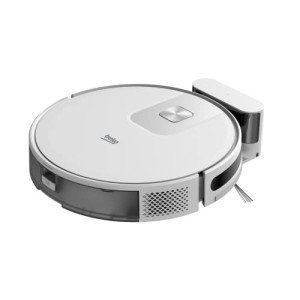12 Companies Are Leading The Way In Robotic Hoover
The Evolution and Impact of Robotic Hoovers in Modern Homes
In the ever-evolving landscape of home technology, couple of developments have caught the general public's imagination quite like robotic hoovers. These automated cleaning devices, when considered a high-end, have actually ended up being progressively commonplace in households worldwide. From their simple starts to the sophisticated designs readily available today, robotic hoovers have transformed the way we consider and carry out family chores. This post looks into the history, innovation, advantages, and possible future advancements of these remarkable machines.

A Brief History of Robotic Hoovers
The principle of a robot that could clean autonomously dates back to the mid-20th century, when science fiction authors and futurists started picturing a future where household tasks would be performed by smart devices. Nevertheless, it wasn't until the late 1990s and early 2000s that the very first commercially feasible robotic hoovers hit the market. The iRobot Roomba, introduced in 2002, is typically credited as the leader in this field. Ever since, many business have entered the marketplace, each bringing its own unique functions and innovations to the table.
How Robotic Hoovers Work
Robotic hoovers operate utilizing a mix of sensors, algorithms, and navigation systems. Here's a breakdown of the crucial parts and innovations:
Sensors
- Laser and Infrared Sensors: These help the robot detect challenges, walls, and drop-offs, ensuring it doesn't drop stairs or get stuck.
- Dust Detection Sensors: These sensors recognize locations with a high concentration of dirt and dust, permitting the robot to focus its cleaning efforts.
- Cliff Sensors: These avoid the robot from falling off edges, such as staircases.
Navigation Systems
- Mapping Technology: Advanced models use mapping innovation to develop a detailed floor plan of the home, optimizing cleaning routes and preventing formerly cleaned up areas.
- SLAM (Simultaneous Localization and Mapping): This technology allows the robot to browse and map its environment in real-time, making modifications as it goes.
Cleaning Mechanisms
- Brush Systems: Most robotic hoovers use a mix of main and side brushes to sweep and gather dirt and particles.
- Suction Power: The strength of the suction is essential for efficient cleaning, particularly on carpets and in hard-to-reach areas.
- HEPA Filters: These filters are utilized in higher-end models to trap allergens and great particles, making them ideal for homes with animals or allergy sufferers.
Connectivity and Control
- Wi-Fi Connectivity: Many modern-day robotic hoovers can be controlled through smartphone apps, permitting users to schedule cleanings, display development, and receive notifications.
- Voice Control: Integration with smart home gadgets like Amazon Alexa and Google Assistant allows hands-free operation.
Advantages of Robotic Hoovers
The adoption of robotic hoovers has brought a number of advantages to modern-day families:
Convenience
- Automated Cleaning: Robotic hoovers can be set to tidy automatically, minimizing the requirement for manual intervention.
- Remote Operation: Users can control and monitor their robotic hoovers from anywhere, utilizing smart device apps or voice commands.
Efficiency
- Enhanced Cleaning Paths: Advanced navigation systems make sure that the robot covers the entire area effectively, reducing the time and energy needed for cleaning.
- Consistency: Robotic hoovers can perform cleaning jobs consistently, preserving a high requirement of tidiness without the need for human supervision.
Cost-Effectiveness
- Long-Term Savings: While the preliminary financial investment may be higher, robotic hoovers can conserve money with time by minimizing the requirement for expert cleaning company.
- Energy Efficiency: Modern designs are created to be energy-efficient, reducing their influence on electricity costs.
Time-Saving
- Releasing Up Time: By automating the cleaning process, users have more time to concentrate on other activities, whether it's work, leisure, or spending quality time with household.
Allergy Relief
- HEPA Filters: These filters can catch allergens and fine particles, improving indoor air quality and supplying relief to allergy patients.
Obstacles and Limitations
Despite their many advantages, robotic hoovers are not without their obstacles:
Initial Setup
- Mapping and Calibration: Setting up a robotic hoover can be lengthy, particularly for bigger homes or those with complicated designs.
- Challenge Identification: Users may need to reorganize furniture or get rid of little challenge make sure the robot can browse easily.
Battery Life
- Minimal Range: Most robotic hoovers have a restricted battery life, which may need them to return to their charging dock before completing a cleaning cycle.
- Frequent Recharging: Some designs might require to charge numerous times during a single cleaning session, which can be inconvenient.
Cleaning Performance
- Dust and Debris Collection: While efficient on tough floorings, some designs struggle with deep-pile carpets or greatly soiled areas.
- Upkeep: Regular cleaning of filters and brushes is necessary to keep optimal efficiency.
Privacy Concerns
- Information Collection: Some users may be worried about the data collected by the robot, including floor maps and user behavior patterns.
Future Developments
The future of robotic hoovers looks promising, with continuous developments in innovation and increasing combination with smart home environments. Here are some possible advancements:
Enhanced Navigation
- AI and Machine Learning: Improved AI and artificial intelligence algorithms will allow robotic hoovers to better comprehend and adjust to their environment, making them more efficient and autonomous.
- 3D Mapping: Three-dimensional mapping technology will allow robots to browse more complicated and chaotic spaces.
Much Better Cleaning Performance
- Multi-Functionality: Future designs might consist of extra features such as mopping and air purification.
- Smart Sensors: Advanced sensors will identify and clean specific kinds of dirt and debris, such as pet hair or sticky substances.
Improved Battery Technology
- Longer Battery Life: Advances in battery innovation will increase the range and duration of cleaning sessions.
- Faster Charging: quicker charging times will lower downtime and make the robotics more easy to use.
Seamless Integration
- Smart Home Ecosystems: Robotic hoovers will integrate more effortlessly with other smart home devices, enabling for collaborated cleaning and home management.
- Voice-Activated Commands: Enhanced voice acknowledgment and natural language processing will make it much easier to control the robot utilizing voice commands.
Regularly Asked Questions (FAQs)
How do I establish a robotic hoover?
- Setting up a robotic hoover normally involves downloading a smartphone app, connecting the robot to your Wi-Fi network, and producing a map of your home. Some designs may need extra calibration or establishing virtual walls to define cleaning locations.
Can robotic hoovers clean up all kinds of floors?
- A lot of robotic hoovers are developed to clean both difficult floors and low-pile carpets. Nevertheless, deep-pile carpets and greatly soiled areas may require extra cleaning or a more effective design.
How frequently do I need to clear the dustbin?
- The frequency of clearing the dustbin depends on the size of your home and how typically the eufy l60 robot Vacuum: powerful 5000 Pa suction cleans up. As a basic guideline, it's a good idea to empty the dustbin after each cleaning session to make sure optimal efficiency.
Are robotic hoovers noisy?
- Modern robotic hoovers are developed to be reasonably quiet, but the noise level can differ depending on the model and the strength of the suction. Some models offer a "peaceful mode" for minimal disturbance.
Can robotic hoovers climb stairs?
- Many robotic hoovers are not designed to climb stairs due to safety concerns. However, some designs can be set to stop briefly at the top of a staircase and resume cleaning on a different floor when by hand moved.
Do I need to remove furniture before using a robotic hoover?
- While some furniture may need to be relocated to allow the robot to tidy below, a lot of models are created to navigate around barriers. It's an excellent concept to remove little items that could hinder the robot's course.
The length of time do robotic hoovers last?
- The life expectancy of a robotic hoover can differ, however numerous designs are designed to last several years with correct maintenance. Regular cleaning of filters and brushes, as well as keeping the robot's software upgraded, can extend its life expectancy.
Are robotic hoovers worth the investment?

- For lots of families, the convenience, efficiency, and time-saving advantages of robotic hoovers make them a worthwhile investment. Nevertheless, it's crucial to consider your specific needs and the features offered by different models before making a purchase.
Robotic hoovers have come a long way given that their beginning, transforming the method we maintain our homes. With their capability to clean autonomously, incorporate with smart home systems, and provide consistent outcomes, they provide a variety of benefits that make them an appealing alternative for many households. As innovation continues to advance, we can expect a lot more advanced and easy to use models to emerge, even more enhancing the cleaning experience. Whether you're a busy professional, a parent, or just somebody who values a tidy home, a robotic hoover may just be the service you've been searching for.
By checking out the history, innovation, benefits, and future of robotic hoovers, this article intends to supply a comprehensive understanding of these innovative cleaning gadgets. For those thinking about a robotic hoover, the FAQs and lists of crucial features can function as important resources in making a notified decision.



